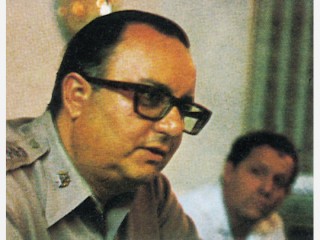
Anastasio Somoza biography
Date of birth : 1896-02-01
Date of death : 1956-09-29
Birthplace : San Marcos, Nicaragua
Nationality : Nicaraguan
Category : Politics
Last modified : 2010-11-27
Credited as : Dictator and military leader, former President of Nicaragua,
The Nicaraguan dictator and military leader Anastasio Somoza (1896-1956) used his position as commander of the national guard to overthrow the government in 1936, and he assumed the presidency in 1937. He ruled Nicaragua as a personal fief and was a hated symbol to many democrats.
Anastasio Somoza, born in San Marcos on Feb. 1, 1896, to Julia Garcia and Anastasio Somoza, a coffee planter, received primary education in his village. After attending the Instituto Nacional de Oriente in Granada, Nicaragua, he went to Philadelphia to study at the Peirce School of Business Administration. While in Philadelphia he met his future wife, Salvadora Debayle, of a prominent Nicaraguan family. Returning to Nicaragua, he entered business; not very successful, he took various jobs before entering political life.
During the Liberal revolution against Emiliano Chamorro and Adolfo Diaz (1926-1927), Somoza joined the Liberal cause. When the Liberals returned to power after the United States-supervised election of 1928, Somoza rose in Nicaraguan politics. Reports attributed this rise to his talent as an interpreter during negotiations ending the revolution and to his charm and dancing ability.
Offices held by Somoza included administrator of taxes and, later, governor of the department of Leon, minister to Costa Rica, and undersecretary and secretary for foreign relations. When the United States prepared to withdraw marines and turn officerships in the United States-trained national guard over to Nicaraguans, President Joso Moncada selected Somoza as commander.
After marine withdrawal on Jan. 2, 1933, and after the guerrilla chief Augusto Sandino made peace with the government in February, strong hostility developed between Somoza and Sandino. This animosity climaxed on the night of Feb. 21, 1934, when members of the national guard abducted and shot Sandino, who was in Managua.
When Somoza, maneuvering for the presidency, became convinced that President Juan Bautista Sacasa was attempting to stall his bid for the high office, he forced the President and the Vice President to resign in June 1936. Following an interim government Somoza was inaugurated on Jan. 1, 1937, after his election in December.
Somoza occupied the presidency until 1956, with the exception of one term, when Leonardo Arguello was allowed the office in 1947. Arguello, too independent, was ejected and replaced by one of Somoza's aged uncles, Victor M. Roman y Reyes. Somoza resumed the presidency in 1950, after his uncle's death.
While attending a banquet in Leon on Sept. 21, 1956, celebrating his renomination by the National Liberal convention, Somoza was shot by Rigoberto Lopez Perez. Somoza died on September 29 in Panama and was buried in Managua.
Manuel Cordero Reyes, Nicaragua under Somoza (1944), is a short anti-Somoza essay by a former Nicaraguan public official. Some discussion of Somoza is in a number of general works: John D. Martz, Central America: The Crisis and the Challenge (1959); Neill Macauley, The Sandino Affair (1967); and William Kamman, A Search for Stability: United States Diplomacy toward Nicaragua, 1925-1933 (1968).
















